As a homesteader, you need to understand what the world has to offer on its abundant plate. As ignorant tourists on the planet, it seems that we turn our noses up at the good free food the Earth has to provide; instead opting for sawdust-filled hamburgers and uranium-colored candy bars.
As a seasoned forager, you not only get to enjoy the deluxe banquet of delights on offer in your very own backyard, you’ll find yourself exploring the world with new eyes. Opening the doors to a myriad of previously unexplored resources, you’ll find yourself accessing edibles, timber, firewood, fibers, and other assets that you’d never noticed before.
As fall dawns upon us and harvest gets into full swing, we’re reminded that nature’s full bounty of a natural harvest also occurs at this time in temperate climates — the reason we follow the pattern.
This article explores how a sensible homesteader recognizes their bounties, harvests and prepares the goods, and creates a self-sufficient yield that goes unnoticed by unwanted guests.
What Is Foraging?
The Cambridge Dictionary describes foraging as going from place to place searching for things that you can eat or use.
This is pretty much what foraging means, however as homesteaders or permaculturists, we’re generally considering natural things to eat and use. That said, permaculture builders looking to craft Earthships may forage for old tires, bottles, cans, and other recyclable materials.
Here, however, we’re focusing on how we forage in our surrounding neighborhoods to find natural prizes to eat and use. These include edible berries, nuts, fruits, and leaves; medicinal herbs, leaves, and flowers; construction and homeware materials; and fibrous sources.
Foraging is the art of identifying that which is useful in nature. By recognizing nature’s gifts to us, we can utilize them to enable us to more freely survive self-sustainably. After all, we are not truly self-sustainable; we work within nature’s remit. That said, while harvesting beyond our means will deplete these resources — regeneratively using them will enable us to work with nature rather than against it.
Foraging is a great example of this permaculture idiom.
Why Is Foraging Important?
As homesteaders, we try to follow some key principles in order to make sure we’re using our time and space wisely.
In this sense, when we consider starting new projects or taking on a task, we consider whether it is worthy of our time, whether it will save us money, and the value of the yield it will produce. Equally, when we find ourselves with a gap in our food systems (such as in late fall and winter), we need to find a solution to this.
Foraging can be bracketed into both these things. Foraging saves us time (not having to grow as many crops) and money (extra food for free), and space (yield grows elsewhere), while also providing us with an extra yield of food to tide us over through the winter months.
In terms of permaculture principles, foraging surpasses itself, embodying a whole spectrum of permie ideology:
Maximum Yield, Minimum Effort
When you’re foraging, you’re looking for wild foods that grow naturally. Mostly perennials, you’ll find them growing in wild clumps or not at all. While native foraging means adjusting your diet, you’ll find a wide range of nutrients on offer on your doorstep.
Foraging means we can reap rewards without having really done much work, benefiting from the naturally regenerative forest food system the world has to offer. While harvesting requires effort, we didn’t have to do anything else!
Using Natural Resources
When growing food ecologically, it makes sense for us all to try to limit our usage of man-made products or unnatural resources. Instead, we prefer the use of leaf drop for compost or paper bags instead of plastic.
When we forage, we using only natural resources. Nature is giving use resources to utilize and we have the opportunity to work with them sparingly. In this sense, it is fair to take a little firewood from a fast growing tree to keep warm and cook food, in the firm knowledge that it will grow back quickly or comes from an area that will benefit from trimming.
Using the Marginalized
When you stroll around Asian cities, like Bangkok, you’ll notice buckets or beds of plants on the sidewalks. Not too dissimilarly to US cities, they are arrangements of plants for aesthetics. What many people don’t realize is that often the local shopkeepers directly in front of these flower arrangements, have done a little work themselves.
Planting native species and hardy perennials, the locals replant these aesthetic pieces with useful resources. They find these resources from foraging around the natural jungle pockets around the river and in the poorer neighborhoods.
Through foraging, they’re able to bring seedlings and seeds to their front step to grow their own bananas, butterfly peas, papayas, mangos, taro, yucca, and spinach. You’ll see this on most bypassed land, forgotten by councils and owners.
When we forage, we utilize these sections of forgotten land and source plants that we previously can’t remember eating. When we forage, we look at the little areas where the nature is sprouting back and see what it has to offer in terms of food, fuel, fiber, or building materials.
Produce No Waste
When we harvest from nature, we’re not producing waste. Foraging from nature doesn’t produce waste. It uses the resources wisely and helps to regenerate. When we pluck flowers, they grow back quickly and vibrantly. When we snip back herbs, they shoot back up again. We’re regenerating instead of devastating.
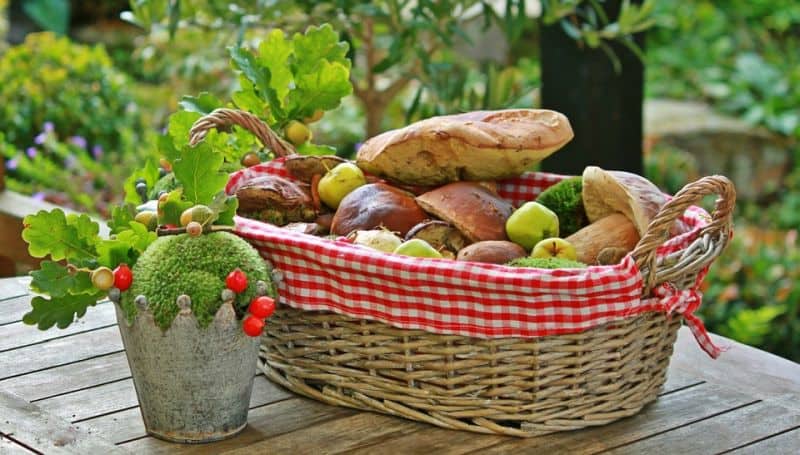
Foraging Foods
Here are a few things you can forage:
Wild Veggies:
Wild Fruits:
- Plums
- Figs
- Damsons
- Berries: blackberries, blueberries, sloe, blackthorne, raspberries, rowan berries
- Persimmons
- Prickly pears
- Grapes
- Autumn Olives
Edible Weeds:
- Nettles
- Dandelion greens
- Mustard greens
- Purslane
- Sheep’s Sorrel
- Plantain
- Chickweed
- Wild violet
- Yarrow
Edible Flowers:
- Nasturtiums
- Calendulas
- Borage
- Violas
- Dandelions
- Arugula
- Violets
Edible Herbs:
- Chives
- Parsley
- Coriander
- Dill
- Mint
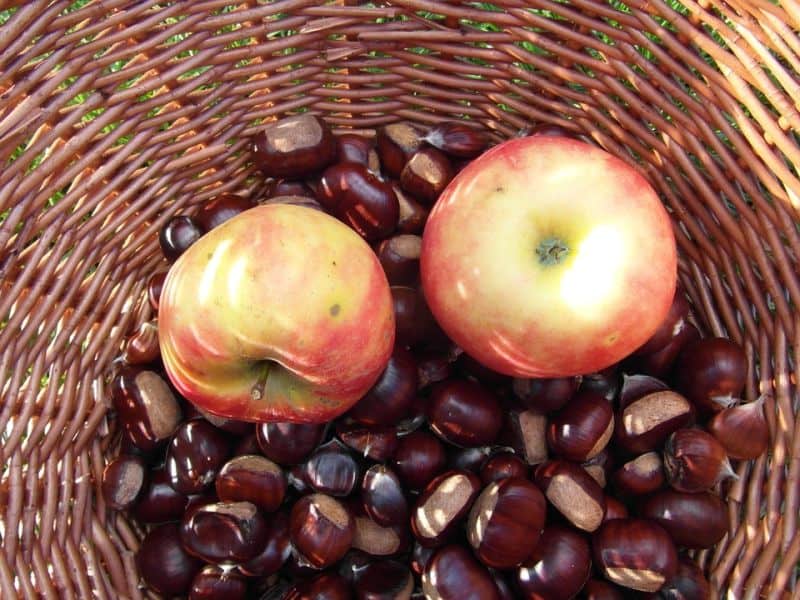
Nuts:
- Walnuts
- Almonds
- Hazelnuts
- Sweet chestnuts
- Beech nuts
- Acorns
- Pine nuts
Mushrooms:
- Chicken of the woods
- Porcini
- Oyster
- Field mushroom
- Chanterelle
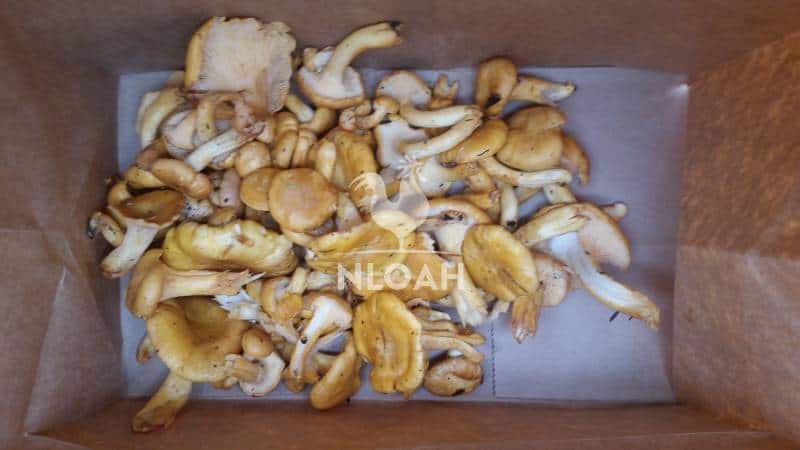
photo above: a bag of chanterelles
Roots and Tubers:
- Squashes
- Dandelion root
- Jerusalem artichoke
- Yucca
- Sweet potato
- Chicory root
You can find examples of even more wild edibles here, just make sure you properly identify a plant or mushroom before harvesting and consuming it.
Foraging Medicine
While nobody is trying to replace Western professional medicine, keeping ourselves healthy with natural resources is always a great parallel plan. Why not look for herbs, leaves, and flowers which can serve as remedies from some of the common conditions we experience, while also serving as preventative medicine to help keep us fit.
Here are a few medicinal plants to keep an eye out for:
- Rosehips – for skin conditions, coughs, and vitamin C boosts
- Elderberries – for coughs, flu and colds, reducing fever, and vitamin C boosts
- Yarrow – to prevent bleeding and help fever
- Goldenrod – for urinary conditions
- Dandelion root – for urinary conditions and kidney problems
- Horsetail – for UTIs, fluid retention, and kidney problems
- Fennel seeds – for bone and teeth strength, digestive comfort, and cough and colds.
- Echinacea – for immune support and white blood cell boosts
- Sage – for sore throats, and antiseptic and anti-inflammatory purposes
- Reishi mushrooms – for a powerful immune boost
- Hawthorn – for heart health and circulation
- Rhodiola – for stress and fatigue
- Thyme – for digestive aid, anemia relief, and as an antibiotic
- Chamomile – for stress, anxiety, and insomnia
- Bilberry – for diarrhea, infections, and scurvy
- St John’s Wort – for depression, anxiety, and fatigue
- Barberry – for diarrhea, fever, and upset stomachs
- Comfrey – for wound-healing compresses
- Burdock root – for blood purification, fever relief, and skin problems (like acne)
- Gentian – for gas relief, heartburn, and relief from vomiting
- Horseradish – for UTIs, kidney stones, gallbladder problems, and gout
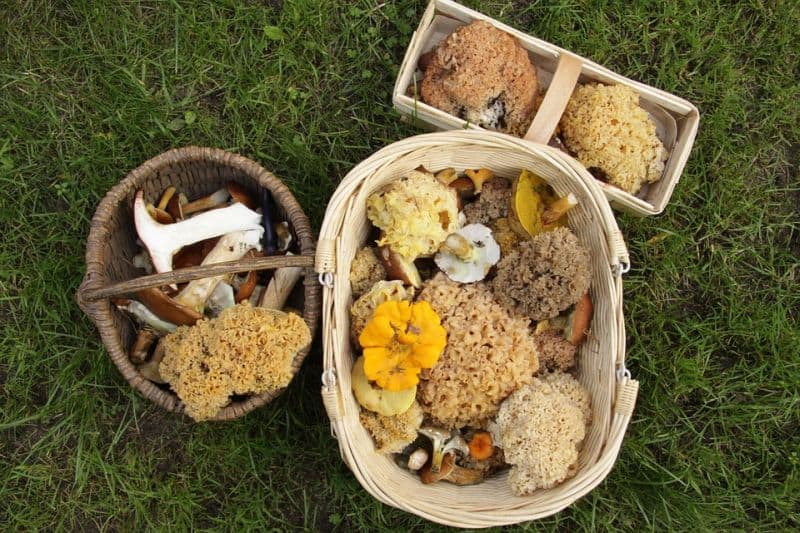
Foraging Materials and Fiber
While sheep’s wool comes as the warmer months keep the sheep from getting cold, you may find other fibers available for foraging in the woods. Some creative companies have been using mushrooms to create a vegan leather. With this fiber, they have created shoes, bags, clothing, and accessories.
In some climates, cutting wood is not allowed in the hot summers due to wildfire policy. This means that the fall becomes the time for cutting and burning. Not only can wood be cut for fires, it can also be cut and seasoned with the view of building in mind. Log cabins and structures can last for many many years, and can serve as housing, animal structures, and storage.
As the wetter weather starts to come in, you’ll find it a little easier to move some of the ground. In this sense, the beginning of fall (before too much rain) is the time to harvest clay for structures. While it may not be the best time to build, clay can be more easily accessed.
Foraging Extras
If you have hungry herds, now is the time to start walking. You can begin by taking your goats and pigs to the edges of your property to keep blackberries at bay at this time of the year. They will root up the brambles and cut back the roughage, while also filling up their bellies.
You’ll also find that the leaf drop becomes a great resource. Start on your own site, scraping up leaves and placing compost piles in accessible places around your garden. If you see neighbors piling black bags outside their homes, take those too. You can always sell them compost back next year!
Forage Water
Don’t forget to get your rainwater structures in place. Finding solutions before the big rains will really make sure you’re saving and preserving, while channeling excess rainwater. This will help tide you over with healthy soil and crops through the barren months, while also lightening your water footprint in the home.
You can use early fall to explore the water pathways on your site to understand the flow and direction. This allows you to observe and build before it really gets heavy.
Dangers of Foraging
People are often worried that they may forage the wrong thing and its turns out to be toxic. Worst case scenario, this could lead to a fatality. Luckily, however, there are few look-a-likes that are so toxic that you’d really suffer.
Despite this, it’ s a good idea to understand the beast you’re working with. Here are some of the common dangers you’ll find when foraging. We like to call it SPARK:
Senses
When foraging, understand from the get-go that you’re using all your senses. You need to be thinking acutely with your sight, smell, touch, hearing, and taste. The problem is that people get confused when they don’t distinguish good eggs from bad by the smell, choosing instead to tuck into some green eggs and ham.
Remember to stay sharp. Feel the find, with all your senses.
Preparation
When people come unprepared for the hike, they get eaten by the bear.
Some of the things we’re foraging for look like other stuff we want to steer clear from. Equally, on a less formidable note, we don’t want to squash our green with heavy carrots.
Carry storage, carry a bag, and carry an extra pair of hands.
Make sure you label everything so you don’t forget as some of this stuff may seem unusual to you.
Attention
Foraging is fun. It’s a whale of a time! You’re skipping through the woods with your friends and family looking for berries and you pop a little something in your mouth. It looks like a blueberry. It smells like a blueberry. But can you be sure.
Before making any decisions, take the time to concentrate and think. Bamboozlement is inevitable if you have a toddler talking your ear off and an angry wife alongside. Keep cool, keep your calm, and pay attention to every berry, mushroom, and leaf that you pick.
Raw Ready Ripe
Some fruits and vegetables need to be cooked in order to be palatable or even edible. Rhubarb is not good for you raw — in fact it can make you very sick. Equally, some unripe fruits may cause you to feel a little nauseous.
In this sense, knowing what you’re looking for and how it is prepared may save someone from sucking their face inside out on a sloe berry.
Know When to Walk
If you’re unsure, walk away. All the old clichés come to haunt you, when you know it is better to be safe than sorry. If something doesn’t look, smell, or even taste right, don’t pick it.
If you have touched something of which you are unsure, wash your hands immediately.
Good Practices When Foraging
We want you to stay healthy and happy in your foraging endeavor and aim for you to stay out of danger’s reach.
It’s this simple, follow these guidelines:
Take a Friend
At the start, using a mentor or a guide will help you get an idea for what you’re looking for. Not only will this prove useful in plant identification, it will also assist you in recognizing the habitats in which forage-able plants grow.
If your senses aren’t up to scratch, bring a friend who can help with that. Say your sight is a little less than optimal, bring a friend with good eyes or a decent magnifying glass!
If you’re in trouble, the friend can call for assistance, especially in the event of unknown allergic attacks.
Surplus Storage
When you’re foraging, you’ll need to store your goods away. While Tupperware seems like the best idea, in the spirit of regeneration, we use mesh bags for mushrooms (so the spores can drop as we walk and grow more mushrooms) and baskets for plants that like to breathe and wet tissue wraps for things with roots.
The problem is that while carrying all this, you may find something you’re unsure about. You need to make sure you have surplus storage. One wrong mushroom in a batch of gooduns will spoil them all.
Research and Bring Material
We’re not in school and this is meant to be fun, but it can also be a little hazardous. It is best to go in with a little idea of what you’re doing otherwise you enter the battlefield blind.
Research what grows in your area in fall and print pictures and descriptions to bring with you. Try to compare them with each of the samples you find. Make sure to research the plants they grow near to give bigger indicators of the habitat your resources are hiding in.
Have a Goal in Mind
Trying to forage for everything at once is doable, however, as noted above, you’ll be packed like a donkey. The problem is that with each separate species, you need a new container.
The other option is to go out with a specific goal in mind. “I want to make cough syrup”, “I’d like an autumnal soup”, “I’m looking to make a fall liquor”.
These goals will point you in the direction of what you’re looking for and will prevent you having to bring an arsenal with you.
Be Ready to Go With Prep
The foraging is just the first step. When returning home with your goodies, you want to ensure you get the best from them. While squashes will last a good few months on the side well-oiled, you might find that herbs start to wilt after a few days.
Preservation and production are key skills to have in place. You can transform your fruits and vegetables into jams, chutneys, leathers, pickles, soups, sauces, compotes, and vinegars; your nuts can become trail mix, flours, oils, and bird feed. You may find yourself making mushroom bags or processing almond milk or elderberry wine.
When you get home, you will want to have the equipment set up and ready to go. If you don’t finish the process, your foraged goods will go bad as you don’t use them. Make nettle soup and freeze or can it; bake acorn carrot cakes and pop them in the larder, make pumpkin and dandelion soups and brew up some forest floor beer! Whatever you do, don’t let it go to waste.
Think Ahead All Year Round
Fall is known as the season of harvest, punctuated with harvest festival and wheat wreaths. Despite this, a true permaculturist is harvesting all year round with staggered yields. This is the same in nature as not all yields are produced at once.
Foraging at all different times of the year will reward you with different results. Summer strawberries give us great popsicle material, while Spring onions give us a dawning kick in our salads.
Foraging all year round will not only diversify your diet, keeping your gut flora healthy, and acting as preventative medicine, it also gives you a chance to process and store all year round. This means less work in the fall to prepare for the winter, as the work was started earlier the previous year. This is especially true in regards to seasoning firewood.
Foraging has something very wholesome about it, something very heartfelt and nostalgic. Walking through the forest with a basket of acorns or baking a cupcake with your grandmother all seems so dreamy.
Foraging not only paves the way to self-sustainability on a year-round basis, it also teaches us to become attuned with nature and its changes. By learning to prepare, both over the long and short-term, we find ourselves rewarding our knowledge and hard work by sighting clusters of raspberries or handfuls of hazelnuts.
Thanks to nature’s ability to push back against our incessant urbanism, she produces fruitful bounties of goods lurking just around your corner. From rowan berry jams to acorn flat breads, you’ll find your geo-specific diet leaving you feeling refreshed, gutful and energetic — ready for the winter months.
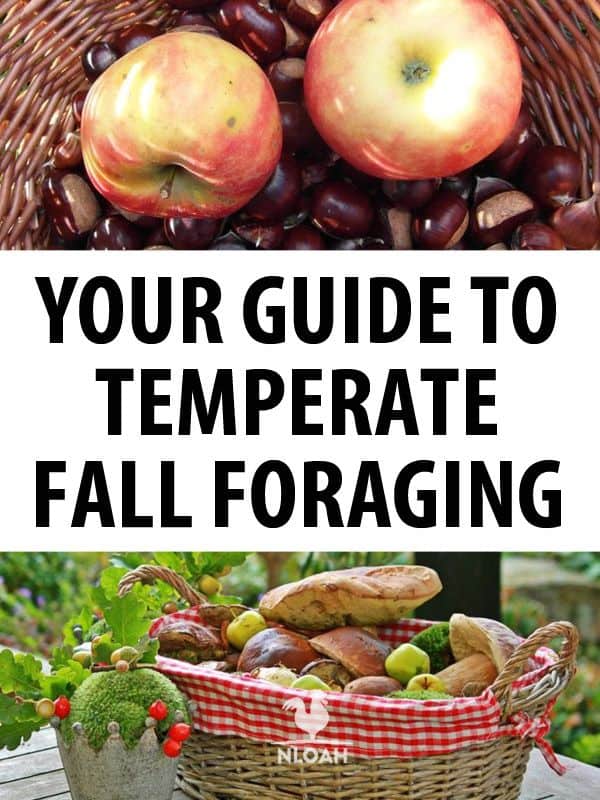
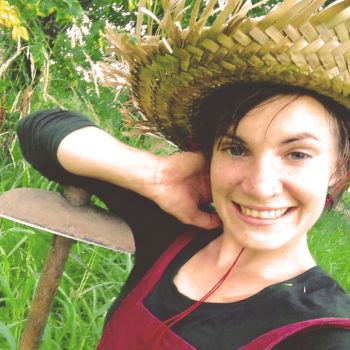
Emmy Jenkins, AKA Permie Emmy, has spent many years traveling around the globe and working remotely, dipping her toes into a myriad of disciplines. Having spent several years volunteering on sustainable farms, Emmy chose to delve deeper into permaculture theory to understand the social and economic patterns often neglected in the philosophy. When she’s not planting edible gardens and frolicking the jungle, she’s consulting on projects around the world to help permaculturalists to understand regenerative ‘Fairshare’ economic patterns and to encourage People Care patterns that focus on biomimicry.
